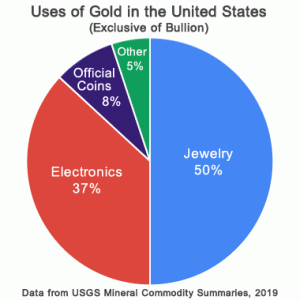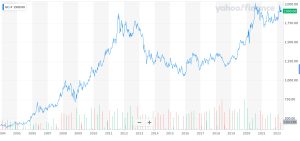
Let’s Talk About Gold
“We have gold because we cannot trust governments.” – U.S. President Herbert Hoover, 1933.
We have been writing our commodities series for almost 8 months now – and in all that time, we have not addressed gold. I must confess part of the reason is trepidation. For the most part, commodities are apolitical. To be sure, in recent years, the rise of environmental, social, and governance criteria (ESG) has politicized hydrocarbon markets, but commodities themselves have no political ideology. Copper does not support the Russian war in Ukraine. Oil does not have an opinion on Taiwan. Bauxite could care less whether the U.S. and Iran rejoin the Joint Comprehensive Plan of Action. Commodities analysis is ultimately about supply and demand – understanding what commodities are and will be in demand, calculating how much of them are available, and understanding how much it costs to get them from point A to B. Figure out the fundamentals and you will go far.
Not so for gold, which has bewitched humans for millennia with its qualities, both tangible and intangible. Even relative to the commodities we have covered in this series thus far, gold is one of the most useful minerals mined from the earth. Gold is highly ductile and malleable, which means it can be shaped to numerous industrial ends. It is also a relatively soft metal, which makes it critical to producing small and delicate circuits and components – which is why gold is used in all sorts of modern technologies, including hard drives and circuit boards. There is a little bit of gold in almost every sophisticated electronic device you use today, whether it is your cell phone, GPS system, or even in some medical devices. Gold does not tarnish and because gold is chemically inactive, it is highly resistant to corrosion. Indeed, the only bad thing about gold is how valuable it is – gold’s worth makes using gold impractical except in cases where no other metal will substitute.
Despite all of gold’s tangible attributes, gold’s primary usage has never been as a traditional commodity, perse. In addition to being a useful metal, gold is also simply a beautiful one. Gold’s luster, color, and occurrence in nature in its natural form have captivated the human imagination for millennia, with gold artifacts found going all the way back to the time of the Egyptian pharaohs. Even today, the primary usage of gold in the United States is in jewelry, not in electronics or other industrial use cases. It is also due to gold’s intangible qualities that gold has been used as a medium of monetary exchange for thousands of years. Long before the idea of fiat currency existed and before FinTwit was arguing about the demise of the dollar as a reserve currency (a topic we reserve for another time), people were trading gold bars and gold coins for goods. (Here’s a link to an extended essay on the use of gold in the ancient Roman and Chinese empires, if you’ve got some free time on your hands.)

Source: https://geology.com/minerals/gold/uses-of-gold.shtml#uses
Gold’s importance in modern finance was not limited to the ancient world. Sir Isaac Newton – yes, the one who discovered gravity – also served as the Master of the Mint and oversaw a shift to a gold standard for British currency. Indeed, for most of the period from 1717-1931, Britain operated either a formal or de facto gold standard. Because the British Empire became the strongest power in the world during this period, so too did the British affinity for gold become commonplace. Even after World War I forced the UK off the gold standard, the British government made reimposing the gold standard one of its top priorities after the war. This is not the time or place to delve into the fascinating history of the gold standard – readers interested in this period of history should read Liaquat Ahamed’s excellent Lords of Finance: The Banker Who Broke the World for more on that subject – it is merely to point out that the human predilection for valuing and hoarding gold is as modern as electricity.
Hence the trepidation in addressing gold directly. Peter Bernstein put it best when he wrote that gold has “developed all the trappings of a full-fledged religion, shared beliefs, high priests, strict codes of behavior, creed, and faith.” Unlike most commodities, gold’s price is not driven by supply and demand related to its industrial usage. It is driven by countries like Russia and China amassing gold reserves to decrease their dependence on the dollar. It is driven by individuals amassing large quantities of gold as a long-term hedge against inflation – or as a way of protecting wealth from the politically-motivated policies of central banks. There can be no doubt that British John Maynard Keynes was technically correct when he opposed the gold standard because tying a country’s economy to the value of a metal with finite supply does not allow for flexible pursuit of economic goals – but it is precisely gold’s unmalleability from a political perspective which makes self-professed “gold bugs” genuflect.
Rather than wade further into this debate, let us soberly take stock of some basic facts about gold’s supply and demand. The top gold producer in the world in 2021 was China, followed closely by Australia, Russia, and the United States. According to the latest USGS data, which only goes up to Q3 2021, global consumption of gold was up in the first nine months of last year in almost all categories: for physical bars by 58 percent, for jewelry by 49 percent, in industrial applications by 16 percent, and in electronics by 13 percent. In addition, while global investments in gold-based exchanged-traded funds decreased by 116 percent over this period, gold holdings in central banks doubled. Unlike most commodities, there is no one country that holds a dominant position in terms of global gold production or reserves, although Australia can lay claim to 20 percent of global reserves. Russia comes in second at 12.6 percent.
Gold is certainly enjoying its time in the sun. The 2008 financial crisis sent gold prices skyward, almost tripling relative to the price in 2005. After the crisis, gold prices receded – but remained elevated compared to their historical average. The pandemic injected new life in the price of gold, and the Russian war in Ukraine has kept gold flirting with the $2,000/ounce level. This reflects the psychology of gold markets, as the combination of debasement of fiat currencies – a favorite topic of TSF Managing Director Sune Sorensen (click here for more), the specter of rising inflation, and the uncertainty around the Russia-Ukraine war have investors looking for safe havens. Whether or not gold is that haven is unclear – but there can be no doubt that for millennia, when times have been bad, people turned to gold as a means of exchange.
From a macro-perspective, there is one more interesting thought to leave you with. While the idea of a formal or de facto gold standard has been around since the early 18th century, the gold standard enjoyed its halcyon days from roughly 1871 (when Germany unified) to the break-out of World War I. In the same way the Concert of Europe tried to keep political stability via preserving territorial and political balances, gold became the fixed medium of exchange for rising and competing great powers. This was also the era when the fruits of the Industrial Revolution were spreading beyond the UK, leading to an unprecedented surge in global trade. Having a common medium of exchange like gold became important because there was no fiscal or monetary structure capable of accommodating massive trade flows that all the powers involved could trust.
The world has not faced a multipolar world like the one the gold standard flourished in since the Guns of August. It would be hubris to say the world is going back to a gold standard – but as the globalization recession deepens, a search for a less politically motivated means of exchange has already begun anew. Gold will always have a seat at that table, not because it is a commodity, but because it has an indefinable characteristic that has made humans value it for millennia – and hopefully for millennia more to come.

